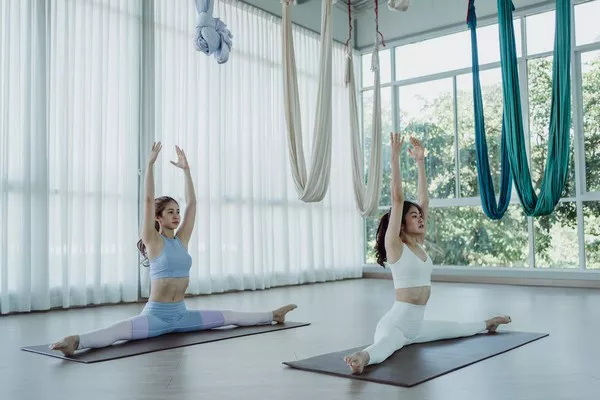In today’s wellness-oriented society, mind-body practices have gained significant popularity as effective means to promote physical fitness, mental well-being, and overall balance. Among these practices, yoga and Pilates are two prominent disciplines that have captured the attention of people seeking holistic health benefits. While both practices share similarities in terms of their focus on mind-body connection and mindful movement, they differ in their origins, principles, techniques, and intended outcomes. This article delves into the intricacies of yoga and Pilates, uncovering their unique characteristics and helping individuals make informed choices based on their personal goals and preferences.
Yoga: Ancient Wisdom Unveiled
Originating in ancient India, yoga is a comprehensive discipline that encompasses physical postures (asanas), breath control (pranayama), meditation, and philosophical teachings. Rooted in spirituality and mindfulness, yoga aims to harmonize the body, mind, and spirit. It emphasizes the union between the individual consciousness and the universal consciousness. Yoga classes typically consist of a series of asanas, pranayama techniques, and meditation practices, allowing practitioners to cultivate flexibility, strength, balance, and inner peace.
Key Features of Yoga:
- Mindfulness: Yoga emphasizes being fully present in the moment, cultivating awareness of breath, sensations, and thoughts. It promotes a state of mindfulness that extends beyond the physical practice.
- Asanas and Pranayama: Physical postures (asanas) and breath control techniques (pranayama) are integral components of yoga. Asanas improve strength, flexibility, and balance, while pranayama regulates the breath, facilitating relaxation and energy flow.
- Meditation and Relaxation: Yoga incorporates meditation and relaxation techniques to calm the mind, reduce stress, and promote mental clarity. These practices encourage self-reflection and inner peace.
- Philosophy and Ethics: Yoga philosophy encompasses teachings on ethical conduct, self-discipline, and self-realization. It explores concepts such as the eight limbs of yoga, which include moral principles (yamas), personal observances (niyamas), and meditation (dhyana).
Pilates: Core Strength and Body Conditioning
Developed by Joseph Pilates in the early 20th century, Pilates is a form of exercise that focuses on building core strength, improving flexibility, and enhancing overall body conditioning. Pilates aims to improve body awareness, alignment, and posture through controlled and precise movements. It combines elements of physical therapy, gymnastics, and ballet, providing a low-impact workout that targets specific muscle groups.
Key Features of Pilates:
- Core Strength: Pilates places a strong emphasis on strengthening the core muscles, including the abdominal, back, and pelvic floor muscles. The exercises are designed to enhance stability, posture, and overall body strength.
- Equipment and Mat-Based Exercises: Pilates can be practiced on specialized equipment, such as the Reformer, Cadillac, or Wunda Chair, which offer resistance and support. Alternatively, it can be performed using a mat, incorporating body weight resistance and small props like resistance bands and exercise balls.
- Precision and Control: Pilates emphasizes precise and controlled movements, focusing on alignment, breath control, and engaging specific muscle groups. It promotes coordination, balance, and body awareness.
- Functional Movement: Pilates exercises are designed to improve functional movement patterns, enhancing overall fitness and performance in daily activities. It aims to strengthen muscles, improve flexibility, and prevent injuries.
Distinguishing Factors: Yoga vs. Pilates
While both yoga and Pilates offer numerous benefits for physical and mental well-being, there are notable distinctions between the two practices:
- Origin and Philosophy: Yoga originated in ancient India as a holistic spiritual practice, encompassing physical, mental, and spiritual aspects. Pilates, on the other hand, was developed as a system of exercise by Joseph Pilates, with a primary focus on physical conditioning and rehabilitation.
- Mind-Body Connection: Yoga places a stronger emphasis on mindfulness, breath control, and spiritual aspects, aiming to integrate the mind, body, and spirit. Pilates, while incorporating mind-body principles, primarily focuses on physical alignment, core strength, and body conditioning.
- Flexibility vs. Strength: Yoga emphasizes flexibility, promoting elongation and stretching of the muscles, joints, and connective tissues. Pilates focuses on strength, particularly core strength, targeting the deep stabilizing muscles of the body.
- Equipment and Props: While yoga primarily uses a mat, with some variations incorporating props like blocks, straps, and bolsters, Pilates offers a wider range of specialized equipment, such as the Reformer, to provide resistance and assistance in performing exercises.
- Breathing Techniques: Yoga incorporates specific breath control techniques (pranayama) as an integral part of the practice, emphasizing the connection between breath and movement. Pilates also emphasizes proper breathing, but the techniques are less complex and more closely tied to enhancing movement patterns.
Choosing the Right Practice for You
The choice between yoga and Pilates ultimately depends on individual preferences, goals, and physical capabilities. If you seek a practice that integrates physical, mental, and spiritual elements while focusing on flexibility, mindfulness, and self-reflection, yoga may be the ideal choice. On the other hand, if you aim to enhance core strength, improve body conditioning, and achieve functional movement patterns, Pilates may be better suited to your needs.
It is worth noting that there is no need to limit oneself to just one practice. Many individuals find value in incorporating aspects of both yoga and Pilates into their wellness routines, creating a well-rounded approach to physical fitness, mental well-being, and overall balance.
Conclusion
Yoga and Pilates are two distinct mind-body practices that offer unique approaches to physical fitness, mental well-being, and overall harmony. While yoga emphasizes spirituality, mindfulness, and flexibility, Pilates focuses on core strength, body conditioning, and precise movements. By understanding the distinguishing features of each practice, individuals can make informed choices based on their goals, preferences, and overall well-being. Ultimately, both yoga and Pilates have the potential to empower individuals to embark on a transformative journey towards holistic health.
Recommended reading:


